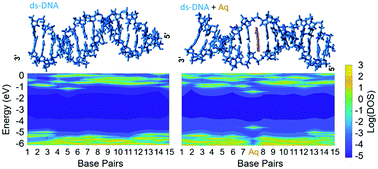Role of intercalation in the electrical properties of nucleic acids for use in molecular electronics†
Abstract
Intercalating ds-DNA/RNA with small molecules can play an essential role in controlling the electron transmission probability for molecular electronics applications such as biosensors, single-molecule transistors, and data storage. However, its applications are limited due to a lack of understanding of the nature of intercalation and electron transport mechanisms. We addressed this long-standing problem by studying the effect of intercalation on both the molecular structure and charge transport along the nucleic acids using molecular dynamics simulations and first-principles calculations coupled with the Green's function method, respectively. The study on anthraquinone and anthraquinone–neomycin conjugate intercalation into short nucleic acids reveals some universal features: (1) the intercalation affects the transmission by two mechanisms: (a) inducing energy levels within the bandgap and (b) shifting the location of the Fermi energy with respect to the molecular orbitals of the nucleic acid, (2) the effect of intercalation was found to be dependent on the redox state of the intercalator: while oxidized anthraquinone decreases, reduced anthraquinone increases the conductance, and (3) the sequence of the intercalated nucleic acid further affects the transmission: lowering the AT-region length was found to enhance the electronic coupling of the intercalator with GC bases, hence yielding an increase of more than four times in conductance. We anticipate our study to inspire designing intercalator–nucleic acid complexes for potential use in molecular electronics via creating a multi-level gating effect.



 Please wait while we load your content...
Please wait while we load your content...